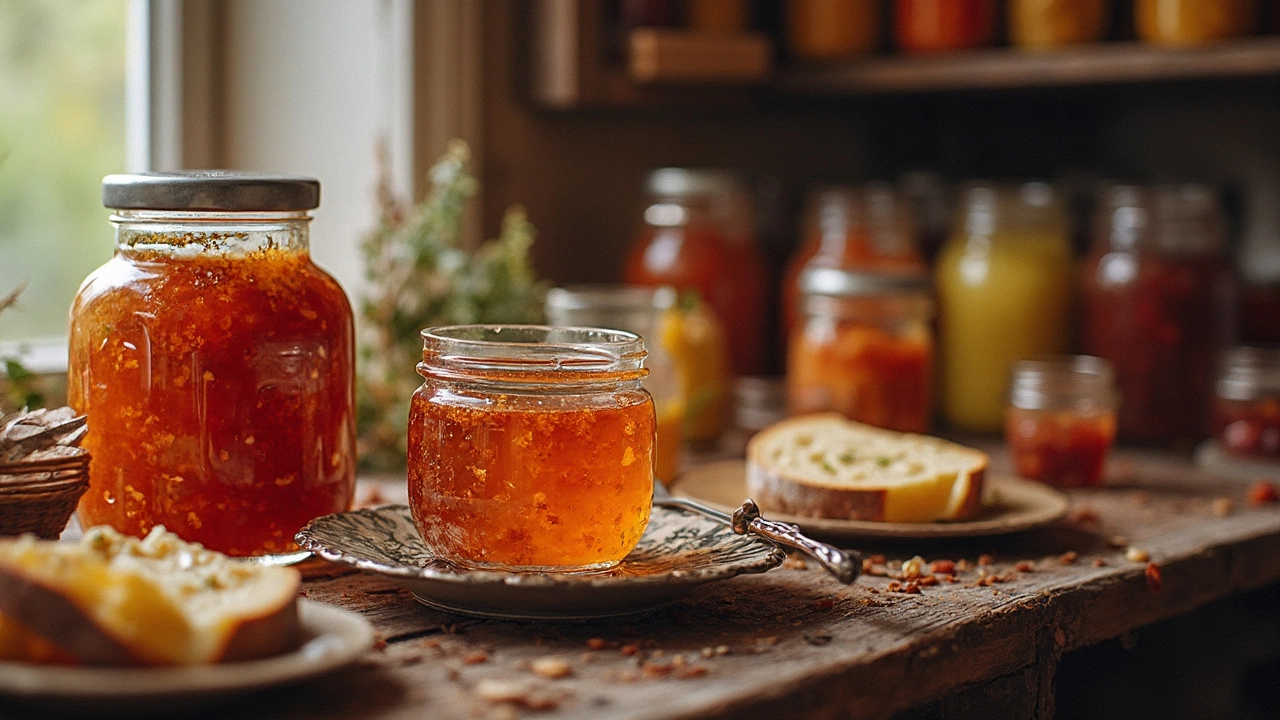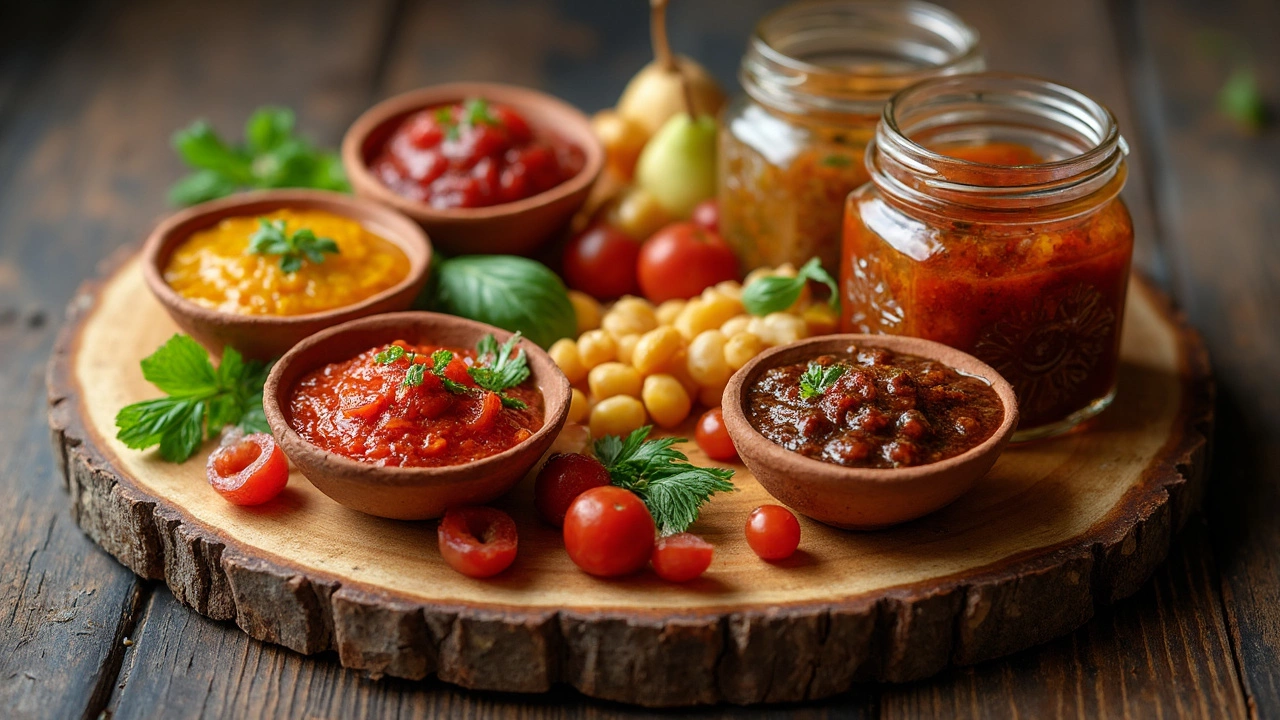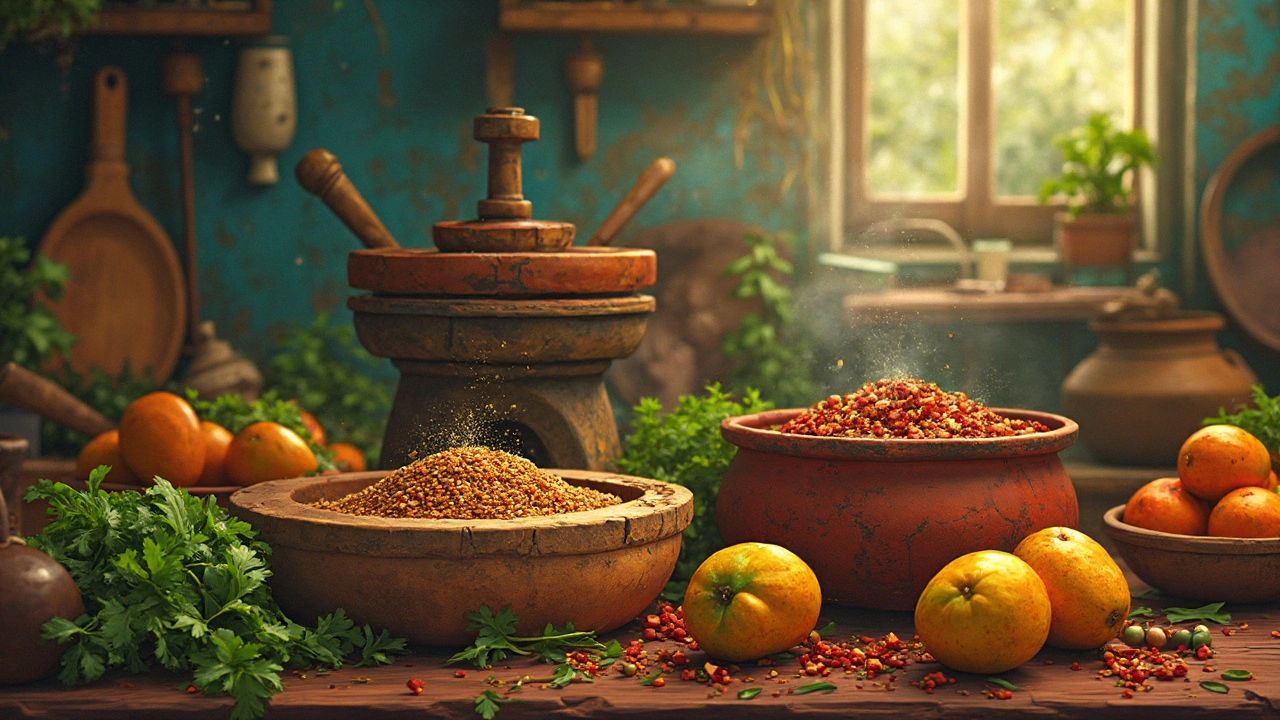Chutney is one of those condiments that's hard to pin down because it can vary so widely. If you’re wondering why Indian and British chutneys seem like cousins that grew up on opposite sides of the world, you’re not wrong. They actually have quite different vibes!
Indian chutneys typically pack a punch with their bold, spicy, and fresh flavors. They can be made out of anything from coconut to mint to tamarind, often served alongside meals to add that extra zing. They're usually freshly made and can be fiery hot or subtly sweet.
On the other hand, British chutneys tend to have a whole different personality. Think of them as the mellow, older cousins. These are more about the slow-cooked flavors, featuring fruit, vinegar, and sugar cooked to a rich, tangy finish. They love hanging out with cheese boards and cold meats.
So, whether you lean towards the spicy kick of Indian chutneys or the sweet tang of British ones, there's something in the chutney world for everyone. And guess what? Making them at home isn’t as hard as it seems when you’ve got a few tricks up your sleeve!
- Origins and History
- Ingredients and Flavors
- Preparation Techniques
- Popular Recipes
- Serving Suggestions and Tips
Origins and History
Chutneys have a rich history tracing back to ancient India, where they were first created as a way to preserve and enhance the flavor of ethnic cuisines. The term 'chutney' is derived from the Hindi word 'chatni,' which means to lick or eat with appetite. It perfectly captures how these condiments are traditionally enjoyed—with great enthusiasm!
In Indian culture, Indian chutney is an integral part of meals, often served alongside rice, bread, or curries. The oldest records show that as early as 500 BC, Indians used pestles and mortars to grind herbs and spices into delicious chutneys. It’s a lost-and-found art where every home or region in India might have its own special recipe.
The British Twist
Fast forward to the 19th century, when the British Empire had a strong presence in India. The British developed a fondness for chutneys, but their version—British chutney—came with a twist. Their adaptation involved cooking fruits with vinegar and sugar, ultimately creating a long-lasting preserve that could handle long voyages back home to England. This resulted in a sweet and tangy condiment that perfectly fitted English cuisine and became popular across Britain.
The love for chutney spread, thanks to the colonial trade, and it found a place on British dining tables, often accompanying the likes of roasts and cheeses. Today, you can find chutneys in many variations all over the world, but they stand as an example of how food cultures can cross barriers and evolve uniquely.
Ingredients and Flavors
When delving into the delicious world of Indian chutney, you’ll find that it's a riot of colors and tastes. These chutneys are typically made using fresh ingredients like coconut, mint, coriander, tamarind, and sometimes even fruits like mangoes. Known for their vibrant flavors, each ingredient plays a specific role, whether it’s adding heat, cooling things down, or layering in sweetness.
Take, for example, the beloved mint chutney. It's refreshing and spicy, often made with mint leaves, green chilies, and a hint of lemon juice to balance it all out. Meanwhile, coconut chutney, a staple in South Indian cuisine, is creamy and slightly sweet, thanks to the grated coconut and a tad of jaggery for that hint of sweetness.
British Chutney Ingredients
Switching over to British chutney, the game changes completely. Here, the focus is on deeper, more mellowed flavors. Apples, pears, tomatoes, and even plums find their way into these chutneys. These key ingredients are usually slow-cooked with vinegar and sugar, resulting in a thick and tangy delight.
For instance, apple chutney is quite popular. It uses tart apples combined with raisins, onions, and spices like ginger and cinnamon. The extended cooking process helps these flavors merge into one harmonious blend that pairs perfectly with sharp cheeses.
| Chutney Type | Common Ingredients |
|---|---|
| Indian Chutney | Mango, Mint, Tamarind, Coconut, Chilies |
| British Chutney | Apples, Vinegar, Onions, Sugar, Ginger |
So, whether you enjoy a chutney that’s fiery and fresh or one that’s sweet and robust, understanding the unique ingredients and flavors of both Indian and British chutney helps you appreciate their special place on the table. And you know what’s great? You can play around with these ingredients to whip up your own signature version!

Preparation Techniques
Getting down to the nitty-gritty of chutney recipes, let's talk about how these flavorful condiments come to life in both Indian and British kitchens. Each has its own quirks and steps, making preparation a unique adventure.
Indian Chutney Techniques
Indian chutneys shine with their fresh and vibrant ingredients. Here's a basic way to whip up an Indian chutney:
- Prep the ingredients: Start with fresh herbs and spices. For instance, a classic mint chutney will need fresh mint leaves, green chilies, lemon juice, and salt.
- Blend: Everything goes into a blender, or if you're keeping it traditional, a mortar and pestle. The aim is to get a smooth paste, adjusting water consistency based on your liking.
- Season: Taste and adjust the salt or lemon juice for that perfect zing. You can also mix in grated coconut for additional texture and flavor.
Indian chutneys are usually made to be consumed fresh, hence the preference for uncooked methods.
British Chutney Techniques
British chutneys take a bit more time due to their cooking process. Here's a general method:
- Gather and chop: The base often starts with fruits like apples or mangoes. Spices like mustard seeds and ginger are popular additions.
- Cook: Ingredients are simmered with sugar and vinegar over low heat, often for an hour or more, until they thicken up and the flavors meld beautifully.
- Bottle: Once cooked, the chutney is jarred while hot, creating a vacuum seal as it cools. This allows it to keep much longer, enhancing those sweet and tangy tastes.
This technique results in a more preserved chutney, perfect for stocking up for later use.
Interesting Tidbit
Did you know that British households consumed approximately 12 million jars of chutney in 2023? Clearly, their love for this tangy delight hasn't waned!
Popular Recipes
Diving into the delicious world of Indian chutney and British chutney recipes is like opening a treasure chest of flavors. Let's get started with some popular recipes that you can whip up at home.
Classic Indian Mint Chutney
If you're a fan of that refreshing kick, mint chutney is your go-to. It's perfect with samosas or as a sandwich spread.
- Ingredients: 1 cup fresh mint leaves, 1/2 cup cilantro leaves, 1 green chili, 1 tsp lemon juice, salt to taste.
- Instructions: Simply blend everything together until smooth. If it’s too thick, add a splash of water. Keep refrigerated and enjoy fresh within a couple of days.
Mango Chutney - British Style
Mango chutney screams British chutneys with its sweet and tangy notes. Pair it with curry or cheese for a delightful contrast.
- Ingredients: 2 ripe mangoes diced, 1 cup sugar, 1/2 cup vinegar, 1 tsp ginger (grated), 1/2 tsp mustard seeds, 1/4 tsp chili powder, salt to taste.
- Instructions: Combine all ingredients in a saucepan. Cook over medium heat until the mixture thickens, stirring occasionally. Let it cool before serving.
Tamarind Chutney
Ideal for those who love a sour twist, tamarind chutney is a hit with Indian street foods like chaat.
- Ingredients: 100g tamarind, 1 cup jaggery (or sugar), 1 tsp cumin powder, 1/2 tsp chili powder, salt to taste.
- Instructions: Soak tamarind in warm water to soften. Once soft, squeeze out the pulp and mix with other ingredients. Stir well till jaggery dissolves completely. Store and serve as a dip.
Trying any of these dishes? Ensure you adjust spices to suit your personal taste. Whether you’re going for the freshness of Indian chutney or the richness of British chutney, there’s plenty of flavors to explore. Happy cooking!

Serving Suggestions and Tips
Chutneys are incredibly versatile condiments that can shine in a variety of settings. Whether you're jazzing up a meal or just snacking, there's a chutney moment for you!
Pairing Indian Chutney
Indian chutney often elevates traditional meals. It’s fantastic with steamed rice, adding a spicy kick to balance plain flavors. If you’ve got a dosa or idli situation, coconut chutney is a classic match.
Don’t shy away from using mint or coriander chutney as a dip for samosas or pakoras. These fresh flavors cut through the richness perfectly.
Savoring British Chutney
British chutney finds its happy place alongside cold meats and cheeses—ever tried it with sharp cheddar on a crusty bread? It’s an absolute winner!
Hearty stews or pies? Add a dollop of mango chutney on the side for some extra depth.
Some Handy Tips
- Storage is key. Store your homemade chutneys in sterilized jars in the fridge to keep them fresher for longer.
- When making chutney with fruits and vegetables, chopping everything at a uniform size helps with even cooking.
- For that classic British flavor, balance the sweetness with the sourness of vinegar and a bit of spice.
Exploring Creative Uses
Think outside the box! Use chutney as a marinade for meats. A mix of fruit chutney and a splash of soy sauce can be an exciting glaze.
If you’re making a sandwich, try spreading a bit of tomato chutney for that sweet-tangy surprise. It can really bring a boring ham sandwich to life!
Got some chutney that's a bit too thick? Stir in a little water or yogurt, and voilà—you’ve got a spiced dressing or dip.
